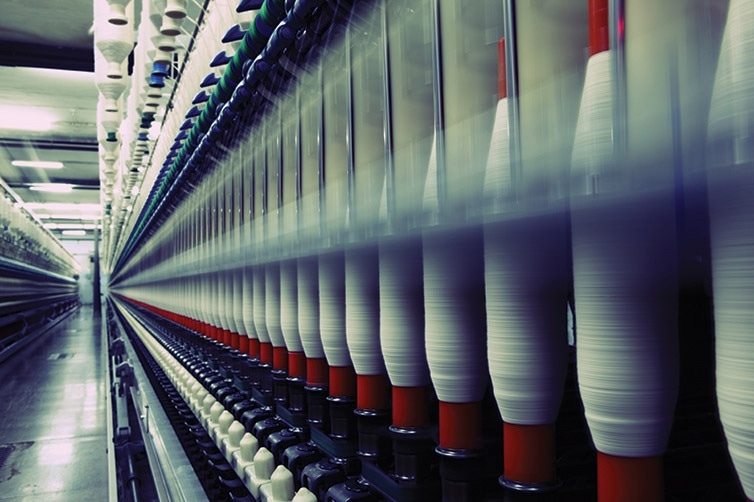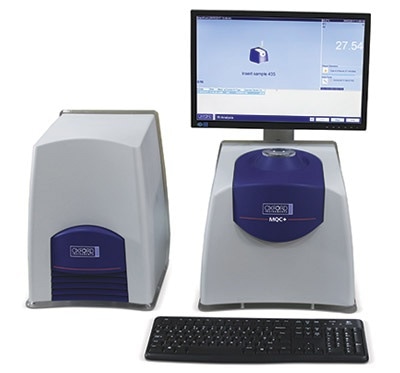One of the largest sectors in the world is the textile industry. Covering extensive global supply chains and a virtually unlimited range of products, both speed and reliability can make a difference between gains and considerable losses.

The use of liquid coatings to regulate and alter the behavior of fibers is considered an essential part of the industrial textile process. Such liquid coatings are meticulously formulated products, usually combining a host of components.
Continual attention is required to make sure that the right amount of liquid coating is applied, to achieve efficient and profitable yarn, fiber, and fabric processing. This implies that potentially hundreds of samples have to be measured 24/7 in a busy manufacturing facility.
The Problem with Traditional Methods
The conventional wet chemistry (solvent extraction) technique has a number of features that do not make it suitable for an industrial setting. For instance, it needs skilled operators, consumes plenty of time, and utilizes hazardous and flammable solvents.

This results in higher running costs, and the consistency of results also relies heavily on the skill of each operator. It can also be costly to dispose of the solvents used in the traditional method in a way that is environmentally acceptable.
The Benefits of Nuclear Magnetic Resonance
Nuclear magnetic resonance (NMR) analyzers eliminate the need for solvent extraction, and the instrument only requires a benchtop in a fairly clean and stable-temperature setting. Also, a fume cupboard is not needed.
Even process operators with minimal training can perform the measurements, generating reliable and operator-independent results. Rapid measurement enables an unlimited number of samples to be quantified every day.
Methodology
NMR analyzers are capable of distinguishing between the hydrogen signal from liquids (like an oil-based coating) and solids (like a textile, yarn, fiber, or nonwoven fabric). These instruments (with a varied sample holder, often called a probe) can also measure liquid coatings based on fluorine.
Flexibility
An immense and ever-increasing range of fiber types is now available. An equivalently wide range of liquid coatings has been created, each customized for use with specific fibers. Most often, the liquid coatings are mainly developed to improve the fiber properties for a specific application or use.
NMR techniques are being advanced to satisfy the needs of such products. Hence, these techniques can be used on a wide range of products, including, but not limited to, textiles, staple fiber, monofilaments, yarn, and non-wovens.
Ease of Use
With the NMR method, liquid coating levels can be measured very easily. After a sample is collected from the production line, it is fed into the instrument. Measurement time is typically 1 minute for each sample. (This may be longer in the case of low concentrations of less than 0.3%.)
Reproducibility
After setting up the initial calibration, Calibration Maintenance Standards (CMSs) can be used to achieve calibration maintenance. Any slight deviations in the instrument can be corrected through the periodic use of the CMSs. This also eliminates the need to quantify a new set of reference samples. CMSs are stable over extended periods and can be utilized to maintain the maximum performance with minimum effort.
Performance
Liquid coating concentrations of just 0.05% have been determined by NMR using the weighing technique; no upper limit exists for the measurable concentration. Samples should be dried before testing if moisture is more than 10%, but this is seldom the case with synthetic fibers.
The MQC+ Method
The MQC+ analyzers from Oxford Instruments now provide operators with next-generation benchtop NMR. As a solution for the textile sector, the analyzers are relatively faster than wet chemical analysis techniques, thus making it possible to measure several samples in a non-destructive manner.

The NMR technique is fast, precise, attractive, user-friendly, and reliable, and it can be used for measuring liquid coating levels in the textile sector. It is an already established technique, which plays a significant role in the most efficient operation of a textile or fiber plant. By ensuring rapid results with minimal user training, the MQC+ analyzer offers the perfect solution for operators requiring pinpoint precision, in a fast and reliable manner.

This information has been sourced, reviewed and adapted from materials provided by Oxford Instruments Magnetic Resonance.
For more information on this source, please visit Oxford Instruments Magnetic Resonance.